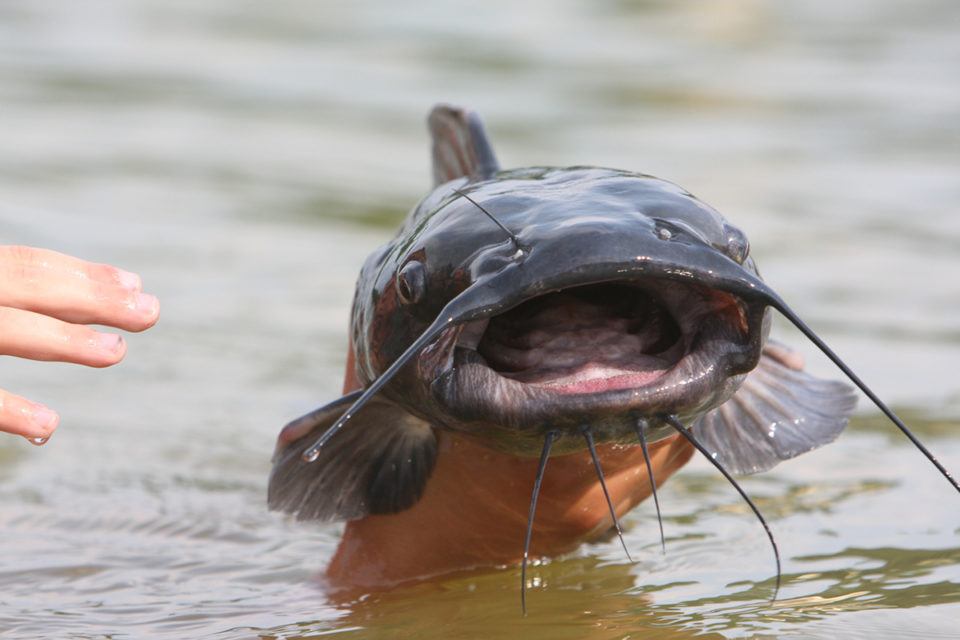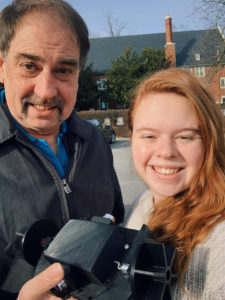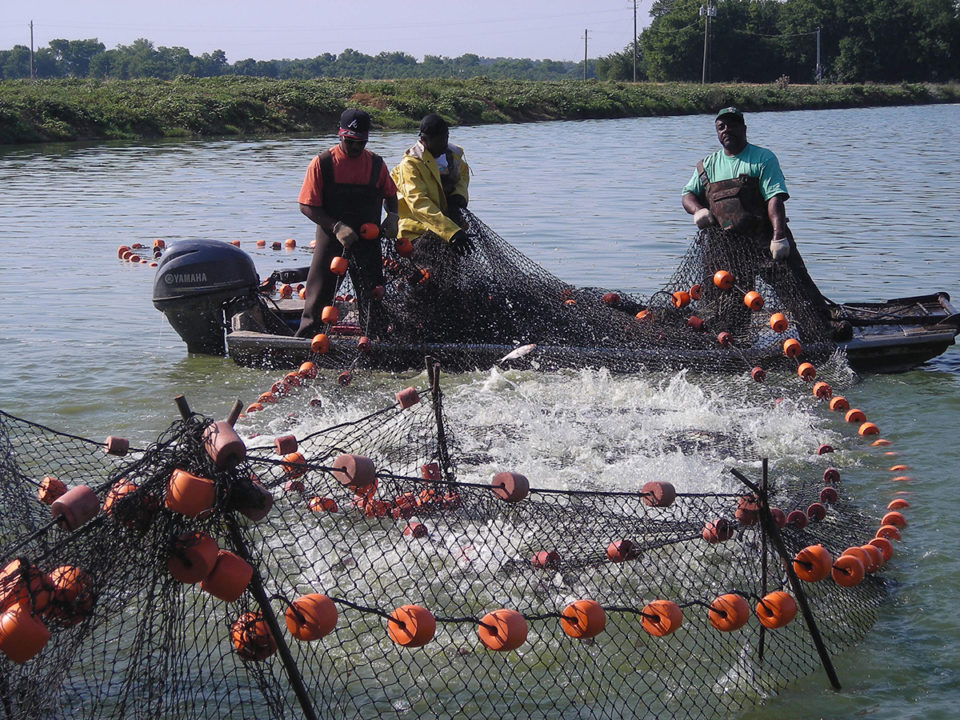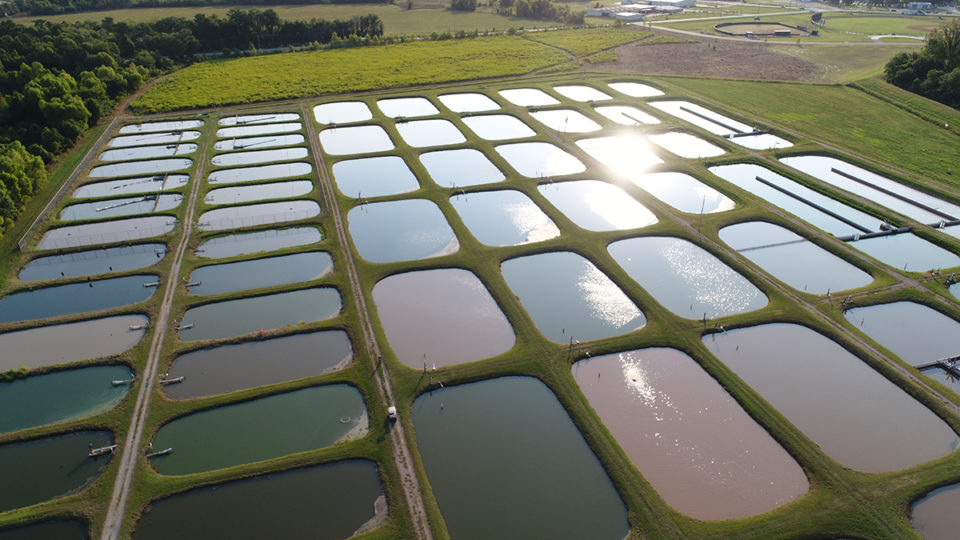Global competition headed by USDA-ARS and HeroX searches for solutions to off-flavors

Dennis and Holly Stilwell know three things about the bacteria in blue-green algae that causes off-flavors in farmed catfish: It gives off a specific color signature, it produces gas bubbles that cause it to float and it cannot survive exposure to ultraviolet light.
The father-daughter team used that knowledge to build Pond Skater, a floating solar-powered robot that roams the surface of a catfish pond, using cameras that detect the color signature and zapping it with UV light. The prototype is their approach to eliminating off-flavors that lead to costly harvesting delays in aquaculture operations.

“The pond skater, being a computerized robotic device, is also a data model; it can collect all of the information about the pond,” said Dennis Stilwell. “It could possibly detect the very chemicals that cause the off-flavors in catfish. If the chemicals are detected well in advance of the harvest, the pond can be treated, fish can be purged and [operators] can avoid a delayed harvest.”
The United States Department of Agriculture – Agricultural Research Service (USDA-ARS) has been experimenting with potential solutions to reduce off-flavors in farmed U.S. catfish for decades but, so far, their scientists have been unable to come up with a viable approach to address the issue, according to Jeffrey Silverstein, deputy administrator for animal production and protection at USDA-ARS.
“Off flavors in farmed catfish is a huge problem that costs millions of dollars to the industry and farmers every year,” Silverstein told the Advocate. “Some of the compounds are not selective and tend to take out blue-green algae and green (good) algae. Some solutions take repeated applications and are not 100 percent effective. Some are too expensive. It’s a complicated situation that’s had active research that hasn’t panned out.”
In 2020, USDA-ARS launched a HeroX challenge, an innovation competition that invited teams to submit ideas for preventing or eliminating the blue-green algae that cause off-flavors in farmed U.S. catfish. The entries could propose pre-harvest management or post-harvest treatments as long as the proposed solutions reduced off-flavors to undetectable levels. Entrants were not required to have professional backgrounds in aquaculture.

Innovation competitions have emerged as a popular option for crowdsourcing solutions to difficult problems.
Competitions like the Aquaculture Innovation Challenge and Fish 2.0 have popped up to address issues in aquaculture; even NASA has invited the public to help solve complex problems. Its Honey, I Shrunk the NASA Payload challenge awarded $160,000 in prizes for instrument designs that could support a sustained human presence on the moon.
“In innovation competitions, very often, long-term problems are often solved by people with tangential expertise,” Silverstein said. “It takes someone coming from a slightly different perspective. A lot of innovation isn’t coming up with an absolute brand-new solution – it’s repurposing a solution that worked in another domain.”
The HeroX challenge launched in August 2020 and attracted 80 entries from around the world, with proposed solutions ranging from pond-skimming robots and charcoal-filled sacks to soak up cyanobacteria to ultrasonic underwater vibrations that decrease the concentration of off-flavor compounds.
Jenna Rackovan and Kimbal Hall from Alden Research Lab pitched an innovation that uses nanobubbles to improve water quality, inhibit cyanobacterial growth and reduce off-flavors. For Hall, the challenge is about more than the cash prize; it represents an opportunity to work with USDA-ARS to turn an idea into a product that helps aquaculture producers. The potential to develop a solution that would replace current chemical treatments was also appealing.
“Currently, the main treatments are with chemicals like a copper sulfate or an algaecide,” Rackovan said. “The benefit [to using nanobubbles] is that it’s environmentally friendly, uses no chemicals and has no effect on the fish or other beneficial organisms in the system.”

Judges with expertise in catfish production, food processing and entrepreneurship in aquaculture will evaluate the proposals select the winners. Judging is currently under way and winners will be announced next month.
“My highest-scoring entries will be those that propose a practical, economical, user-friendly approach that producers can use to address this issue,” said Jimmy Avery, extension professor at the National Warmwater Aquaculture Center at Mississippi State University.
Entrants agreed to grant USDA-ARS rights to develop the technology while retaining their own rights to develop the idea and pursue patents. The winning team will be awarded $60,000.
Once the competition is over, Silverstein hopes that winning inventors will partner with USDA-ARS scientists to evaluate the viability of their ideas at federal research facilities. He calls it a “bold new step” in to bring innovation into the program.
Follow the Advocate on Twitter @GAA_Advocate
Now that you've finished reading the article ...
… we hope you’ll consider supporting our mission to document the evolution of the global aquaculture industry and share our vast network of contributors’ expansive knowledge every week.
By becoming a Global Seafood Alliance member, you’re ensuring that all of the pre-competitive work we do through member benefits, resources and events can continue. Individual membership costs just $50 a year. GSA individual and corporate members receive complimentary access to a series of GOAL virtual events beginning in April. Join now.
Not a GSA member? Join us.
Author
-

Jodi Helmer
Jodi Helmer is a North Carolina-based journalist covering the business of food and farming.
Tagged With
Related Posts

Aquafeeds
Catfish nutrition: A look at feeds and feeding practices
Information on catfish nutrition was practically nonexistent in the late 1950s and early 1960s when catfish farming first started.

Innovation & Investment
Robins McIntosh: Florida RAS shrimp farm the first of many
CP Foods’ Robins McIntosh is turning a 40-acre site in Florida into a next-generation shrimp farm, producing 1,000 tons annually with zero waste.

Innovation & Investment
Tuna aquaculture: Fishing for progress
Aquaculture could be a sustainable alternative to fishing for tuna but achieving commercial-scale production has proven challenging.

Intelligence
Farmers trade Kansas cornfields for Florida clam beds
The Stones came to Florida without experience in clams and no ties to the fishing community. Their backgrounds in farming, however, are proving valuable.

